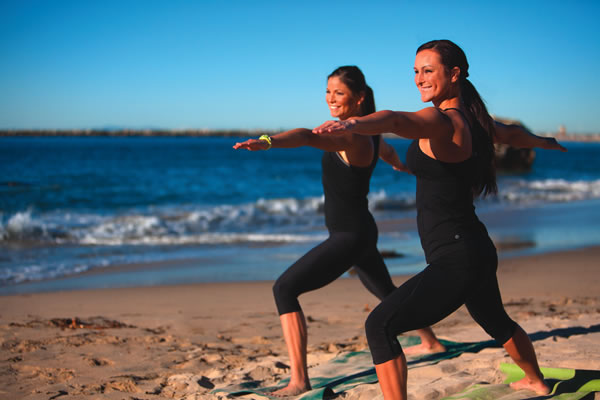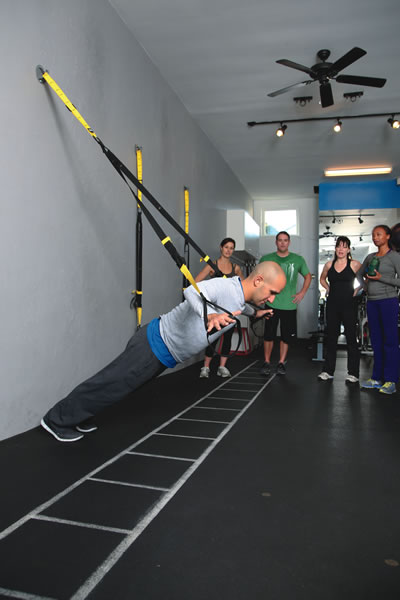Local fitness pros share how to get the most out of 30 minutes or less
By Dana Nichols | Photo by Scott Sporleder
 Some days it feels like there’s a hidden treasure trove of bonus time that some people have access to while the rest of us try to keep up—and keep our New Year’s resolutions. Daily workouts get pushed aside when bustling careers and busy home lives take over. Having fewer daylight hours doesn’t help.
Some days it feels like there’s a hidden treasure trove of bonus time that some people have access to while the rest of us try to keep up—and keep our New Year’s resolutions. Daily workouts get pushed aside when bustling careers and busy home lives take over. Having fewer daylight hours doesn’t help.
Fitness experts in Newport Beach understand that many of us simply run out of time for daily routines. But if there’s any place on the planet where one should be able to fit in a workout regimen, it’s here in Newport Beach, where ground-breaking fusion-Pilates studios, state-of-the-art gyms and top-notch personal trainers—who will come to your home—are all within reach. Not to mention endless bike paths, running trails and stretches of beach. The secret to fitting in daily workouts doesn’t need to be a mystery. “Health and fitness is not about being harsh on yourself, but developing yourself. Workouts can be 30 minutes and effective if they’re focused,” says Ryan Campbell, trainer and fitness manager at Equinox Newport Beach and a corrective exercise specialist. While there’s no password that allots one an extra hour in the day (although that would be nice, wouldn’t it?), speedy workouts can come to the rescue.
Every Little Bit Counts
First things first: Get over your guilt. If you can’t find an hour every day to hit the training circuit, you’re not alone, and bad feelings over the lack of time go nowhere fast. “Stress is one of the leading factors of all illnesses, so try not to add on the extra guilt of feeling bad about not being able to workout on a given day. Focus on the big picture,” says Shannon Barbadian, co-owner of Corona del Mar’s Defy Gravity Studio, who has taught in the fitness industry for 20 years. She encourages her clients to carve out a minimum of 20 minutes for themselves each day, even if it’s just for practicing good posture and breathing.
The hour-a-day workout is a common misconception, says personal trainer Kai Kelly of Fitness by Kai in Newport Beach. “This false belief blocks the opportunity to fully utilize the minutes in your day,” she says. “Shorter, high-intensity workouts are more effective than longer, slow-paced workouts, and have the ability to boost your metabolism for up to 24 hours.”
The best way to make extra time is by starting early, Ryan suggests. He recommends a pre-dawn wake-up call. “Busy people typically need to commit to getting up early and winning the day before their day starts,” he says. “Either get a trainer to be there for you at 5:30 a.m., or get into a group setting. I used to train a boot camp class at 5:30 a.m., and it was composed of all female professionals and mothers. They would work out and get home before the kids ever woke up.”
You’ve got only 30 minutes to spend at the gym, so why bother, right? Wrong. To best maximize your limited time, Shannon recommends breaking a sweat in an intense 30-minute cycle class (“to help burn those holiday calories right off”) followed by her favorite type of core work: planks, which build strength in the abs and back by stabilizing the body in a push-up-like position. Her alternative is incorporating planks into an easy-to-remember rotation of three intense movements that can be done in 20 or 30 minutes in any gym: jumping rope, squats, a series of planks. Jumping is a fast-moving cardio exercise, squats work every muscle in the legs and planks strengthen the core. Plus, planks can be easily switched up with other versions of the traditional pose, such as plank pike, mountain climber and even jumping jacks. Repeat several times, and you’ll feel your heart rate liven up in no time, she says.
How many times a week does a brief gym workout need to be repeated for it to be effective? Many people wonder if they should save their time for longer workouts at the gym, less frequently. Corona del Mar-based personal trainer Steve de la Torre says “no.” The body responds to intensity better than frequency, duration and the chosen movement. “If you don’t have time, it doesn’t really matter because your body doesn’t respond to how long you’re exercising—it responds much better to how hard you’re exercising.” The CrossFit certified trainer and owner of PT-Revolution praises the Tabata method, a workout that takes only four minutes. It’s one movement, performed rapidly—for example, 20 seconds of squats, running in place or pushups followed by 10 seconds of rest, eight times. “The little rest and the short amount of exercise allow you to keep a very high intensity,” Steve explains. “The amount of work is equivalent to doing 15 or 20 minutes of a low grade type of cardio. You can get a lot done in a very short period of time.”
At Home
Home DVDs, the best of which include three things—cardio, core work and flexibility training—are the perfect motivation for some, but others find them too long or monotonous. Ryan suggests coming up with a few body weight activities, like arm or leg exercises (using the back of a chair for balance). “There are plenty of things around the house to manipulate your body and make a fun and challenging workout using only body weight,” he says. Staying focused on productivity is key. “If you’re time sensitive, don’t [waste it focusing on] single body parts. … Go for complexity such as a dumbbell squat curl, where the exercise requires a lot of body parts and movement. More movement means more muscles involved, which translates to more calories burned.”
Moving fast requires pre-planning so that when the clock strikes “break time,” you’ve got a series of two-in-one exercises that can be performed swiftly. Increasing the intensity of a workout by doing arms and legs at once can free up both your schedule and your peace of mind—two invaluable possessions, whether your daily routine means keeping up with back-to-back meetings, play dates or diaper changes.
Erica Ziel, a Pilates instructor at Body Design in Newport who specializes in prenatal and postnatal fitness, has one word she uses more than any other: “incorporate.” Her No. 1 concept for the busy Newport Beach moms who run to her for help in shedding baby pounds while dealing with the demands of motherhood, is also combining two exercises into one simultaneous movement. “To do something intense where you keep your heart pounding and your muscles burning for 10 minutes is way better than doing nothing,” explains the mother of three children under the age of 6. “Doing more full body and combo work is going to get your heart rate up higher because you’re moving your arms and your legs at the same time.”
On the Street
Many fitness experts agree that the best workout activities done outdoors are fun sports that make the time fly by. In Newport Beach, a few of these are surfing, SUP, sailing, hiking and running—but you have to move fast to do them in a half an hour. Surfboard or not, every opportunity outside is an opportunity to move. Parents who take their kids to the park can do pushups and arm-dips on a park bench, Erica says. She also advises runners to add lunges or squats into their routines. Of course, sprinting is the fastest way to a more intense workout. Try a 30-second or 60-second sprint, or divide it up by blocks: sprint a block, walk a block, repeat. “The old favorites really do add up,” Shannon says, adding, “Park as far away as you can when shopping, take the stairs instead of the elevator and always practice good posture.”
For those who travel, Kai advises that planning ahead and having healthy snacks on-hand is key. She recommends an endurance workout that can be done with zero equipment in a compact hotel room: a minute of crunches, a minute of jumping jacks and a minute of pushups, followed by 45 seconds of a rocking plank, then jumping lunges and squats. “Added pulses in between each set of 10 will have every muscle in your lower body on fire,” she says. “Grab a granola or protein bar, light string cheese, almonds or fruit. Having a healthy snack to munch on in between meals will help keep your metabolism boosted.”
While letting the benefits of small workouts add up, the best benefit of incorporating even the briefest workouts into your daily routine (or four minutes, if that’s all you have) is regularity. “Consistency is the second hardest part about working out, after getting to the gym,” Ryan says. If you’ve already tackled the hardest part—deciding to take the initial steps—the rest should be a piece of cake. NBM







